ODEC files
ODEC files are similar to NMEA0183 sentences, but they also store binary data. This format is used by SyQwest to encode bathymetric data. You can now use the raw data import wizard to use the data in Hydromagic Survey, or use the data in Hydromagic Dredging (after processing the raw data and generating a matrix file from the soundings).
$PNTI,103,M,5,0,0,0,0,15,0,G,*16 $PNTI,105,O,1,60,0,8,31,4835,0,I,*1A $PNTI,171,10/13/05,09:41:17,0.40,*0E $PNTI,111,I,1,03675,0,0060,0000,03296,[binary data] $PNTI,151,10/13/05,09:41:17.13, 43.098412967,-76.212088367, 0.0, 0.0,*30 $PNTI,111,I,2,00000,0,0060,0000,03296,[binary data] $PNTI,151,10/13/05,09:41:17.19, 43.098412550,-76.212090467, 0.0, 0.0,*3C $PNTI,111,I,1,03675,0,0060,0000,03296,[binary data] $PNTI,151,10/13/05,09:41:17.24, 43.098412550,-76.212090467, 0.0, 0.0,*32Example ODEC data file
Starting the raw data import wizard
All file formats which Hydromagic is able to convert to proprietary raw data files, can be imported through the "Import Data Wizard". To start the wizard, right-click the "Raw Data" folder in the "Project Explorer" and select the 'Import Data Wizard...' option:
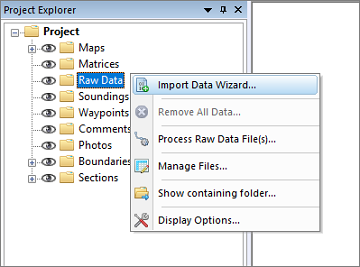
The "Import Data Wizard" can be launched from the "Project Explorer".
Select file format
The first page of the wizard allows you to set the format of the file(s) we wish to import. Since this tutorial is about importing ODEC data files, we select the 'ODEC Files (*.odc)' option from the drop-down list.
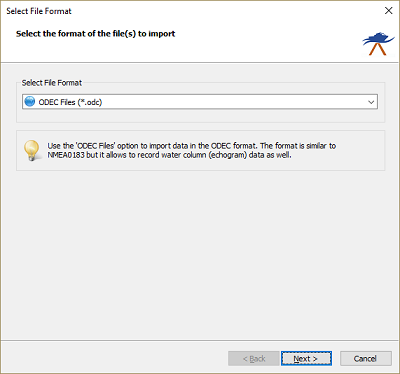
Select the "ODEC files" format from the dropdown list.
Select file(s) to import
On the second page of the wizard, you can select which files to import. Click the 'Browse...' button to select the folder on your computer where the files are stored. After changing the folder, the file list is reloaded, and you can use the checkboxes to select one or more files to import at a time.
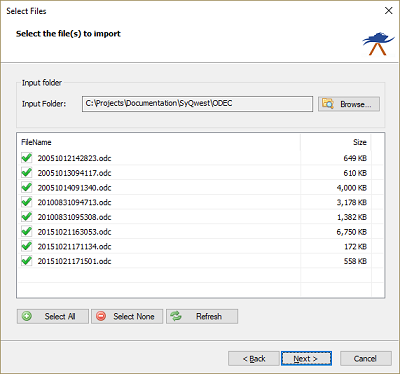
Select the file(s) to import. You can import multiple files at a time.
Import options
Since the draft is not always stored within the ODC file, you can set the transducer draft on the 'Advanced Settings' page:
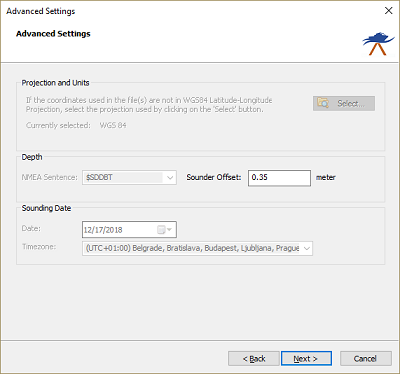
From the 'Advanced Settings' page, you can set the transducer offset or static draft.
When the format has been selected and the file(s) have been selected, you can start the import process by clicking the 'Finish' button on the last page of the wizard.
The file currently being processed is displayed in the status bar at the bottom of the screen, and the wizard shows a message box stating 'File(s) successfully imported as raw data file(s)' as soon as the process is complete. Click 'OK' to close the dialog, and the imported files will be centered in the map view (only if they contain position data). After importing raw data files, you can download a background map of the covered survey area using the built-in map downloading tool.
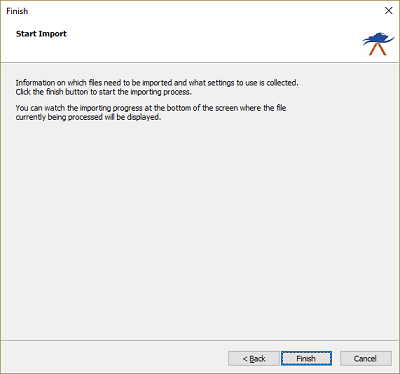
After clicking the "Finish" button, the import process will start.
Checking the imported raw data file(s)
When the import is complete, you can right-click the generated raw data files and select "Analyze Data..." to inspect the imported values and timestamps. If the import did not complete successfully, refer to the 'Processing' tab of the activity view for more details on the error shown.
